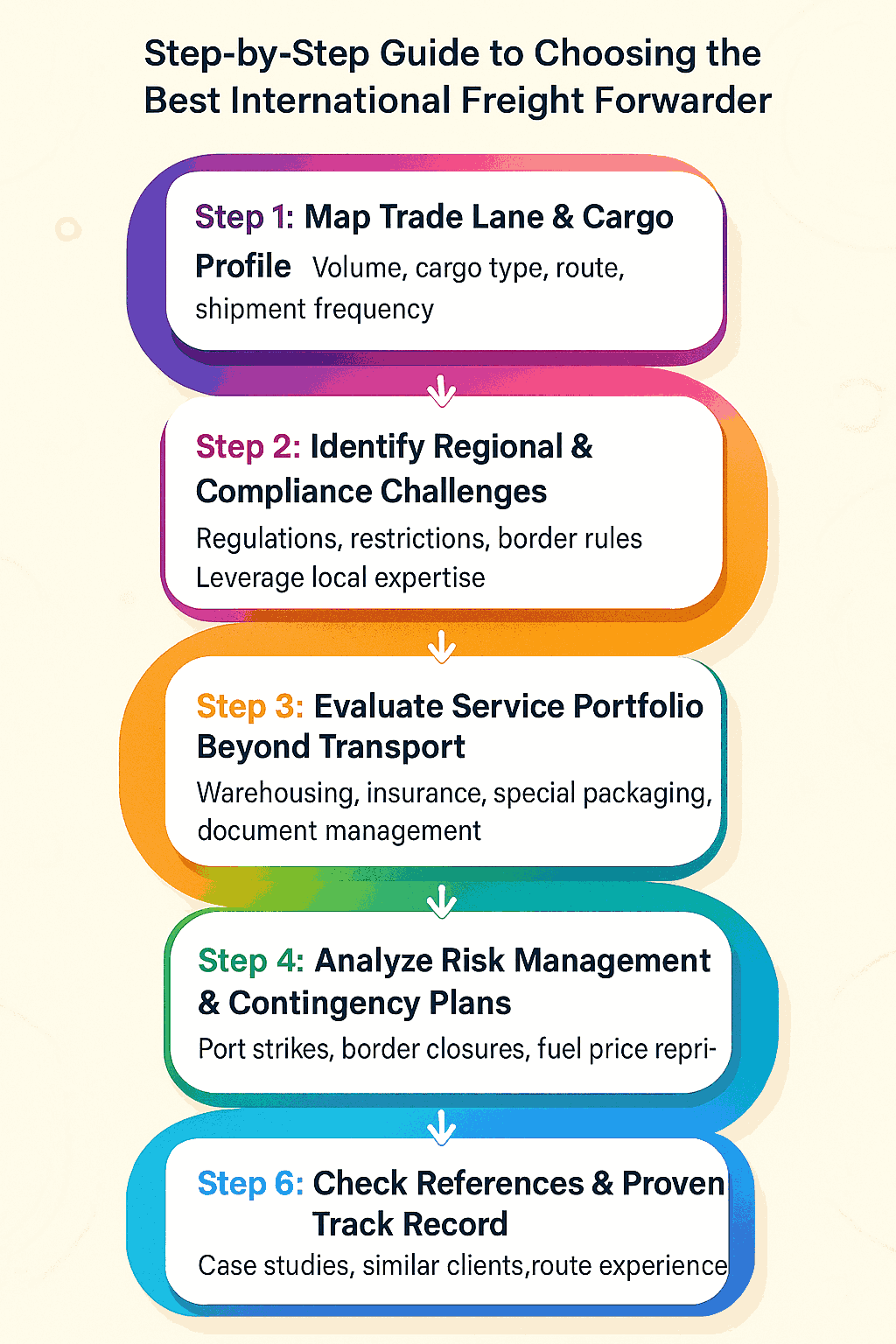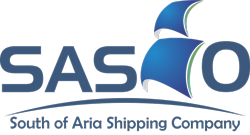Why Choosing Top International Freight forwarder Matters?
Selecting the right best international freight forwarder is more important than it may seem. International shipping involves complex processes: navigating customs regulations, coordinating with multiple carriers, and managing various land, air, and sea routes. Even a small mistake can lead to delays, unexpected costs, or logistical issues.
For example, imagine an Indian company wants to ship industrial goods to European countries, such as Germany or Poland. The shipment first departs from the port of Mumbai and enters Iran through southern ports, either Chabahar or Bandar Abbas. Within Iran, the cargo must traverse northern and western land routes and exit through border crossings such as Bazargan or Sarakhs. After leaving Iran, the shipment continues through Turkey or the Caucasus countries before reaching Europe.
Each country along this route has its own specific customs regulations:
- India: Export documents and legal permits for the shipment are required, including commercial invoices, bills of lading, and packing lists; certain industrial goods also require quality or technical compliance certificates before departure.
- Iran: Entry through ports such as Chabahar or Bandar Abbas requires international transit permits. Shipments must pass through designated border crossings with coordination from customs authorities, comply with vehicle weight and type restrictions, and, in some cases, obtain temporary import approvals for certain industrial items.
- Turkey / Caucasus: Upon leaving Iran, the shipment enters Turkey (Bazargan–Gökçik border), where customs documents are checked and cargo inspections may occur. In the Caucasus (e.g., Georgia or Azerbaijan), goods must have certificates of origin and international transit documents (TIR Carnet), and restrictions on vehicle type and cargo volume may cause short or multi-hour delays.
In such a scenario, choosing the best international freight forwarder experienced in the India–Iran–Europe route—familiar with each country’s regulations and equipped with contingency plans for potential delays—ensures shipments arrive on time, without issues, and at minimal cost. This example illustrates that selecting the right freight forwarder is not just a logistical decision but a strategic choice critical to international business success.
Step-by-Step Guide to Choosing the Best International Freight Forwarder
Step 1: Map Your Trade Lane and Cargo Profile
The first step in selecting the best international freight forwarder is to map your trade lane and define your cargo profile in detail. You need to know the volume, type of goods (industrial, perishable, temperature-sensitive, etc.), exact shipping route, and shipment frequency. This foundational information helps you identify forwarders with experience and expertise in handling your specific cargo and routes. For example, shipping industrial goods from Europe to Asia via Iran–Turkey–Europe requires in-depth knowledge of transit regulations and border management, while frequent shipments of perishable goods from Asia to Europe require precise planning for air transport and refrigerated storage. Without this detailed profile, choosing the right forwarder is almost impossible.
How to Measure?
- Check cargo volume and type with your production or warehouse team.
- Identify the exact route and shipment frequency from past orders or contracts.
- Prepare a simple table with the specifications of each shipment.
Step 2: Identify Regional & Compliance Challenges
Assessing regional challenges and customs compliance is crucial. Each international route has its own risks and regulations. For instance, Central Asian routes often involve complex land borders, weight restrictions, special transit permits, and random inspections that can result in delays of several hours or even days. Using a best international freight forwarder without local expertise may lead to prolonged stops and unexpected costs. Therefore, partnering with a local freight forwarder familiar with Central Asian laws and regulations is critical to navigate these routes efficiently.
In contrast, routes to the European Union impose strict requirements on product standards, safety, and labeling. A top international freight forwarder with experience across regions can manage both types of routes effectively and provide practical solutions for each region’s challenges. Freight forwarders rankings can help identify companies that have proven expertise in managing complex regional compliance issues.
How to Measure?
- Collect regulations and restrictions from official websites and local offices.
- Consult with a local freight forwarder and list potential challenges and solutions.
Step 3: Evaluate Service Portfolio Beyond Transport
A true best international freight forwarder offers more than just transportation. Ancillary services such as warehousing, cargo insurance, customs clearance, special packaging, and document management are equally important. A forwarder that provides a full-service portfolio minimizes unnecessary delays and additional costs while delivering a seamless shipping experience. Many competitors focus only on transportation, but a complete service offering is a key differentiator for a top international freight forwarder.
How to Measure?
- Match each forwarder’s service list with your needs.
- Use a short questionnaire: “Do they offer warehousing, insurance, special packaging, and document management?”
Step 4: Assess Technology Integration with Your Business
Digital systems and integration capabilities now deliver real value. A best global logistics provider should be able to integrate with your ERP or supply chain management system, provide real-time data, and support accurate reporting. Tracking alone is insufficient; real value is created when systems automatically synchronize order information, inventory, and cargo status with your internal systems. This enables faster decision-making and reduces human errors.
How to Measure?
- Check if their tracking system can integrate with your ERP.
- Request sample reports and digital dashboards.
Step 5: Analyze Risk Management and Contingency Plans
Risk management is a critical factor. A professional forwarder has contingency plans for unexpected events such as port strikes, fuel price fluctuations, border closures, or other logistical disruptions. These plans include alternative routes, coordination with local carriers, and management of additional legal or customs documentation. Without such plans, even routine shipments may encounter significant delays and extra costs.
How to Measure?
- List possible route risks and review each forwarder’s contingency plan.
- Simulate hypothetical scenarios like strikes or border closures.
Step 6: Check References and Proven Track Record
Reviewing case studies, previous clients, and references is essential. The forwarder should have experience with similar shipments in your industry and on the same route, and you should be able to verify real examples or direct referrals. Using the Top Freight Forwarders List helps identify forwarders with a proven track record and reliable performance on international routes. A checklist of questions can include: “Have they handled similar clients?”, “How did they manage route-specific risks?”, and “Can they provide successful case examples?”
How to Measure?
- Review real case studies with similar clients.
- Contact at least 2–3 previous clients to verify their experience.
Step 7: Compare Costs in Terms of Total Value
True shipping costs go beyond the base freight rate. Hidden expenses such as demurrage, extra warehousing, insurance, customs penalties, and potential delays must be considered. A best international freight forwarder provides transparent pricing and a comprehensive assessment of total value, allowing for informed decision-making and minimizing financial risks.
How to Measure?
- Collect all costs (base rate, demurrage, extra warehousing, customs penalties) and compare in a table.
- Calculate the total value of each offer considering all services and risks.

Common Mistakes Businesses Make When Choosing a Freight Forwarder
1. Focusing Too Much on Price
Many businesses make the mistake of selecting a freight forwarder solely based on the lowest price. While cost is important, choosing a cheap option without considering reliability can lead to delays, hidden fees, or damaged cargo. A best international freight forwarder balances cost with service quality, compliance, and risk management, ensuring your shipments reach their destination on time and safely.
2. Relying on Marketing and Professional Appearance
Some businesses rely solely on a forwarder’s website, promotional videos, or advertised claims. This can be risky because it doesn’t reveal the company’s real experience or ability to handle routes and risks. Always check verified track records, past clients, and actual shipment examples.
3. Ignoring Sudden Changes in Regulations and Rates
International freight is dynamic, and fuel costs, customs regulations, and regional restrictions can change rapidly. A business that only focuses on the initial contract without contingency planning may face unexpected delays and extra charges.
4. Pressuring the Forwarder Without Proper Route Planning
Attempting to expedite shipments without coordinating with routes or border capacities can result in long hold-ups and additional fines. A best international freight forwarder provides precise scheduling and practical contingency plans.
5. Overlooking Value-Added Services
Some businesses assume that transportation alone covers all needs. Ignoring services such as insurance, warehousing, special packaging, or document management can lead to hidden costs and operational risks. The real value of a top international freight forwarder lies in these additional services and their ability to minimize practical risks.
FAQs About the Best International Freight Forwarder
- 1. What makes a freight forwarder the best international option for my business?
A best international freight forwarder does more than just transport goods. They have proven expertise across multiple trade lanes, ensure regulatory compliance, manage risks, and provide value-added services such as warehousing, cargo insurance, and document management. - 2. How can I verify a forwarder’s reliability for international shipments?
Check their track record with clients in similar industries and trade lanes. Ask for references and review their performance in handling customs, delays, and compliance challenges. A top international freight forwarder should be able to provide verifiable examples. - 3. Should I choose a global or regional freight forwarder for international routes?
It depends on your trade lanes. Global forwarders offer broad network coverage, but sometimes a regional or local partner is essential to navigate specific customs regulations or complex border requirements. Often, a combination provides the best results. - 4. Can a freight forwarder help optimize total shipping costs?
Yes. Beyond base rates, a best international freight forwarder considers hidden costs such as demurrage, extra storage, and customs penalties, offering strategies to reduce total logistics expenses without compromising reliability. - 5. What value-added services should I expect from a top international freight forwarder?
Services like cargo insurance, inspected warehousing, specialized packaging, export documentation, and integration with ERP or supply chain systems are critical. These services reduce risks, streamline operations, and ensure shipments arrive on time and compliant with regulations.
Final Thoughts
Choosing the right best international freight forwarder not only reduces logistical and customs risks but also increases efficiency across the entire supply chain. An experienced and reliable partner can expertly manage complex international routes, minimize hidden costs, and optimize delivery times.
SASCO, as one of the top international freight forwarders, offers an extensive network, practical experience across international trade lanes, and comprehensive logistics services, making it an ideal choice for businesses seeking security, speed, and cost-efficiency in global shipping.







